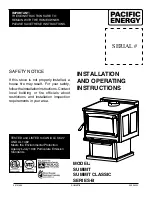
JINHCN05 RevE 22/07/14
L
OCOMOTIVE
G
RATE
Your Cleanburn Stove is fitted with a locomotive
type grate. So that de-ashing can be carried out
cleanly and easily, it is riddled from the outside of
the stove with the doors closed.
B
URNING
W
OOD
For optimal performance when burning wood,
open the grate by pushing the operating tool away
from you.
L
IGHTING
We recommend that you have two or three small
fires before you operate your stove to its
maximum heat output. This is to allow the paint
to cure in steadily and to give a long service life to
the paint finish. During this curing in process you
may notice an unpleasant smell. It is non-toxic,
but for your comfort we would suggest that
during this period you leave all doors and
windows open.
Open both air controls fully and light one or two
firelighters placed centrally on the grate, allowing
the flames to become established before placing
several pieces of small dry kindling in a criss-cross
fashion above the firelighters, taking care not to
smother the fire. Close the stove door. Once the
kindling is well alight open the door and build the
fire by gradually adding slightly larger pieces of
wood, closing the door afterwards.
Once the fire is established close the Primary Air
Control
(slide control fully to your left) and add
more fuel as necessary. The Secondary Air Control
can be used to regulate the burn rate of the stove.
Should the fire fail to light correctly
open the door
and use a poker to spread the fuel across the
bottom of the firebox. Close the door and allow
the fuel and stove to cool before attempting to
relight the fire.
N.B. Leaving the air controls in the closed position,
adding too much fuel or using wood that is wet or
too large will prevent the fire from establishing
correctly and may result in smoke emission from
the stove.
When the stove is up to operating temperature
the operating tool or gloves should be used to
operate the air controls.
R
EDUCED
C
OMBUSTION
In order to shut down the stove, reduce the
primary and secondary air by sliding both controls
to the left.
If the controls are left in this position, the fire will
be starved of air and will die down.
If you want to revive the fire it is recommended
that the primary air control is opened first, and
then the secondary air control.
Warning!-
The stove will remain
hot
for a
considerable time after the fire has been
extinguished.
T
HE
C
LEAN
A
IR
A
CT
1993
AND
S
MOKE
C
ONTROL
A
REAS
Under the Clean Air Act 1993 local authorities may
declare the whole or part of the district of the
authority to be a smoke control area. It is an
offence to emit smoke from a chimney of a
building, from a furnace or from any fixed boiler if
located in a designated smoke control area. It is
also an offence to acquire an "unauthorised fuel"
for use within a smoke control area unless it is
used in an "exempt" appliance ("exempted" from
the controls which generally apply in the smoke
control area).
The Secretary of State for Environment, Food and
Rural Affairs has powers under the Act to
authorise smokeless fuels or exempt appliances
for use in smoke control areas in England. In
Scotland and Wales this power rests with Ministers
in the devolved administrations for those
countries. Separate legislation, the Clean Air
(Northern Ireland) Order 1981, applies in Northern
Ireland. Therefore it is a requirement that fuels


































